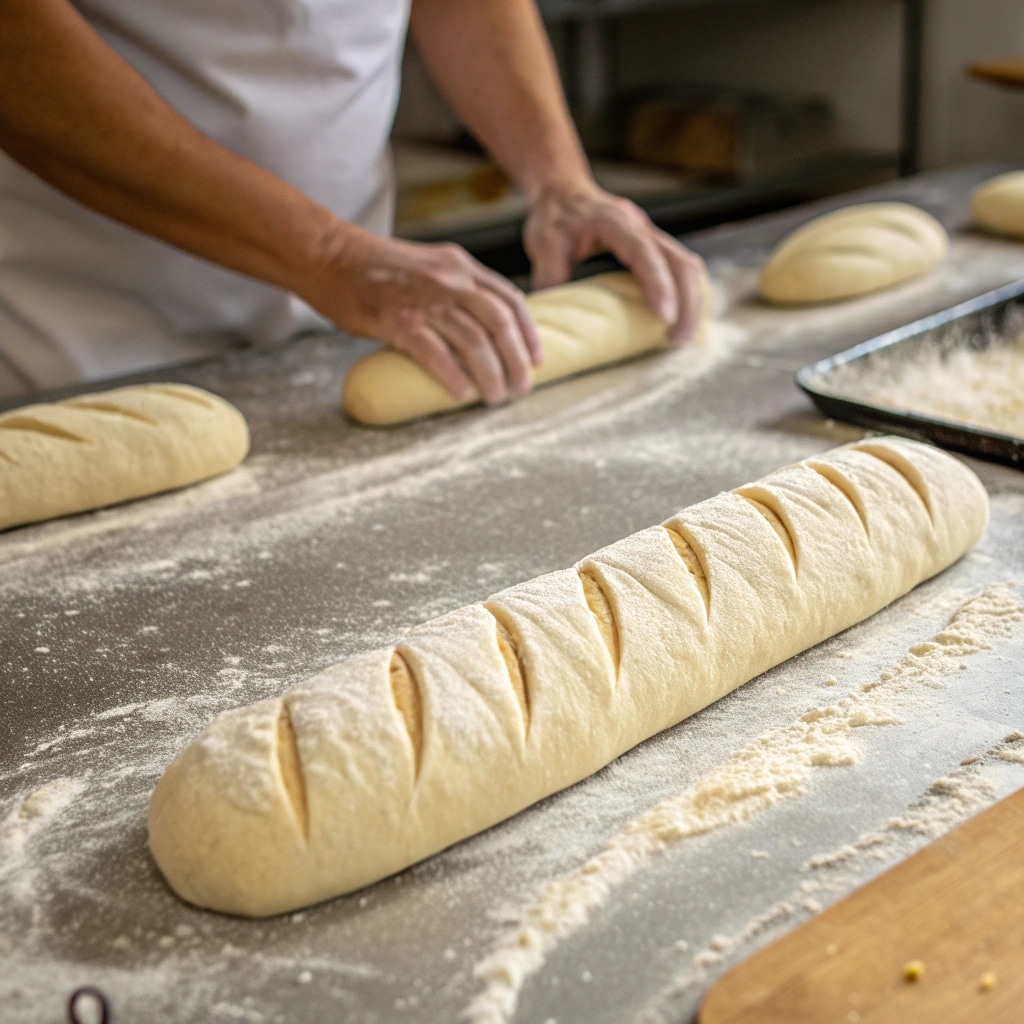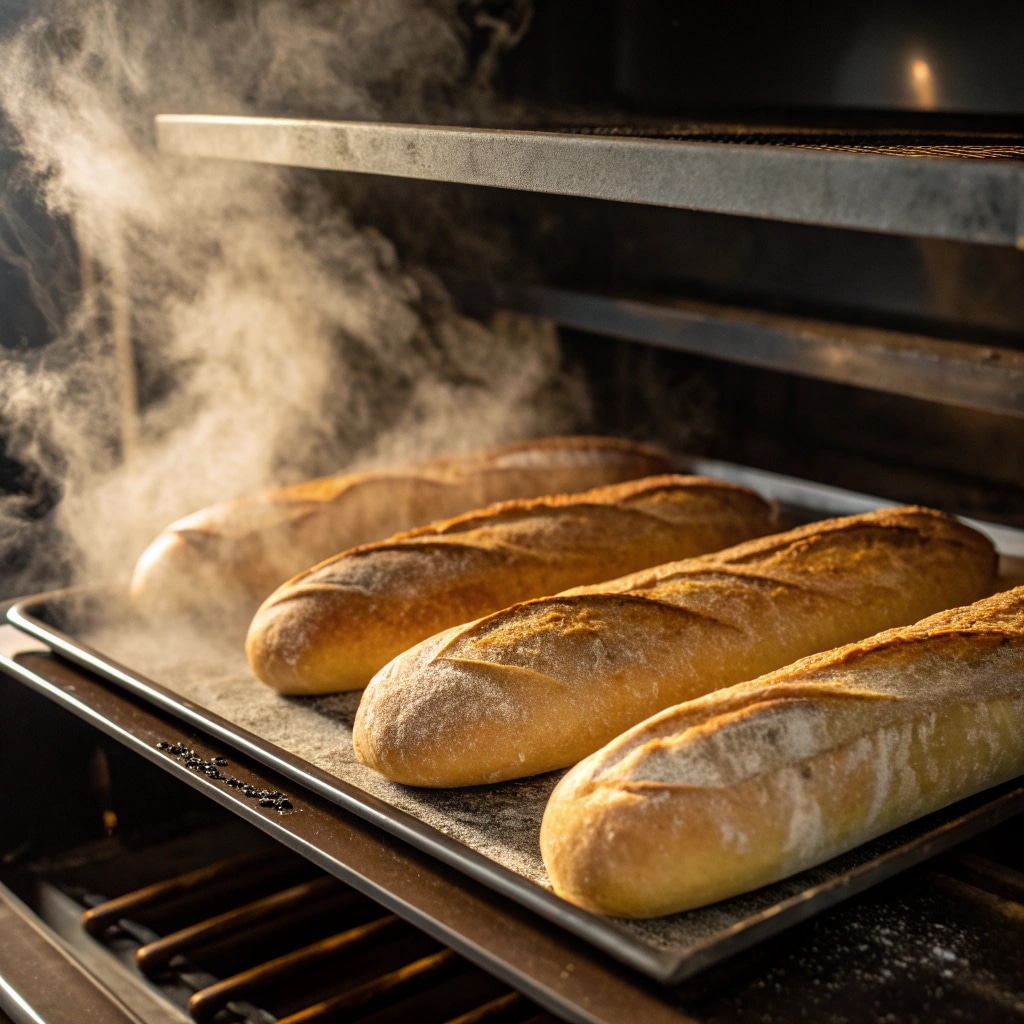There’s nothing quite like the crackle of a fresh sourdough baguette recipe when you slice into it. The golden crust flakes, the steam escapes, and suddenly your kitchen feels like a tiny Paris bakery. I still remember the first time I pulled an artisan sourdough baguette from my oven—the smell of warm bread made me forget every misstep it took to get there. That’s the beauty of a homemade baguette recipe: even the practice loaves taste wonderful.

In this guide, I’ll share two paths to mastering baguettes at home. One is the classic, slow-rise sourdough baguette recipe—a traditional sourdough recipe that rewards your patience with depth of flavor, open crumb, and a rustic baguette loaf worthy of a French countryside table. The other is a quick sourdough baguette recipe, perfect for busy days when you crave that sourdough tang without the long wait. Whether you’re after a classic French sourdough baguette or a same-day bake, both methods will help you achieve a bakery-style baguette at home.
Making French sourdough bread doesn’t require a wood-fired oven or a diploma in pastry arts. With the right starter, flour, and some encouragement, you’ll soon find that an easy sourdough baguette recipe for beginners is well within reach.
Table of Contents
Which Method Is Right for You?
When I first started baking baguettes, I quickly learned that not all recipes fit every lifestyle. Some days, I had time to babysit dough through hours of fermentation; others, I needed bread on the table by dinner. That’s when I realized there are really two ways to approach the sourdough baguette recipe: slow and traditional, or quick and hybrid.
Classic sourdough baguette
If you’re chasing authenticity, this is your path. Using only flour, water, salt, and an active baguette sourdough starter, the dough develops slowly. You’ll get that coveted sour tang, a chewy interior, and a sourdough baguette crust that sings when you tap it. Expect long fermentation, a proper autolyse, and folds that build structure for an open crumb sourdough baguette. This method feels like baking history into every loaf. It’s patient and soulful, much like a traditional sourdough recipe. If you’re unsure about starter care, I’ve shared tips in my guide on feeding sourdough starter.
Quick hybrid baguette
On busy days, I lean into this shortcut. A pinch of instant yeast alongside your sourdough starter speeds up proofing time, cutting hours off the process. The result? A loaf that still carries sourdough’s flavor but is ready in a single afternoon. It’s an easy sourdough baguette for beginners and ideal if you’re just starting. Many bakers wonder about the sourdough baguette vs French baguette—this hybrid sits somewhere in between, offering a faster fermentation without losing all the tang.
Whichever path you choose, remember: bread should work for your schedule, not against it. Both methods honor tradition in their own way, and both deliver loaves that taste far better than store-bought. And if you’ve ever worried about health aspects, you can check my guide on is sourdough bread gluten-free to understand why sourdough might be gentler on digestion.
Ingredients You’ll Need
Every great sourdough baguette recipe starts with a few pantry staples, but the proportions and timing make all the difference. Whether you’re after a rustic baguette loaf with that deep sour tang or a quick sourdough baguette recipe you can bake the same day, these are the ingredients you’ll need.
Classic Sourdough Baguette Recipe (makes 3 baguettes)
- 4 cups bread flour – If you’re wondering about the best flour for sourdough baguette, bread flour delivers the chewy texture and open crumb you expect.
- 1 ½ cups water – This gives a hydration level around 70%, perfect for manageable dough.
- 2 teaspoons fine sea salt – Just enough to balance and deepen flavor.
- ½ cup active sourdough starter – A bubbly baguette sourdough starter is the backbone of every traditional sourdough recipe.
Hybrid Quick Sourdough Baguette (makes 3 baguettes)
- 4 cups bread or all-purpose flour
- 1 ⅓ cups water – Slightly less than the classic version for easier shaping.
- 2 teaspoons salt
- ⅓ cup active sourdough starter
- ½ teaspoon instant yeast – Just a pinch to speed up proofing while keeping sourdough character.
- 1 tablespoon honey or olive oil (optional) – Honey adds a touch of sweetness, while olive oil softens the sourdough baguette crust.
When I first began baking baguettes, I was amazed at how these same few ingredients could create loaves with such different personalities. The classic method rewards patience with bold flavor and chewy bite, while the hybrid is ideal for beginners chasing an easy sourdough baguette recipe. It reminds me of the joy of pulling sourdough cinnamon rolls from the oven—another recipe where sourdough proves its versatility.
Whether you lean toward a traditional sourdough baguette recipe or a quick sourdough baguette recipe, these ingredients show that bakery-style bread is within anyone’s reach at home.
Step-by-Step Instructions
Classic Sourdough Baguette Recipe
When I first tried a classic sourdough baguette recipe, I remember being intimidated by the timeline. But once you break it into steps, it feels surprisingly doable. Here’s exactly how to make sourdough baguette step by step.
- Feed your starter the night before. You’ll need ½ cup of bubbly, active starter for this dough. A sluggish starter won’t give you that lift or flavor.
- Mix and autolyse: In a large bowl, combine 4 cups flour and 1 ½ cups water. Let it rest 30 minutes before adding 2 tsp salt and ½ cup starter. This helps gluten form naturally.
- Stretch and folds: Over the next 2 hours, stretch and fold the dough 3–4 times. This replaces kneading and strengthens the structure for that open crumb sourdough baguette.
- Bulk ferment: Cover and let the dough rise 4–6 hours at room temp, or until doubled.
- Cold fermentation: Transfer to the fridge overnight (8–12 hours). This slow rise deepens the flavor and creates a bakery-style baguette at home.
- Shape baguettes: Gently divide into three pieces. Roll each into a long cylinder, tucking ends under for that classic French sourdough baguette look.

- Proofing time: Place baguettes on a floured couche or parchment-lined tray, cover, and proof 1–2 hours until puffy.
- Score the dough: Use a razor or sharp knife to slash each loaf at a shallow angle. How to score sourdough baguette is all about confidence—quick, clean cuts.
- Steam bake: Preheat oven to 475°F with a baking stone or heavy tray inside. Slide baguettes onto hot surface, add a tray of water or ice for steam, and bake 20–25 minutes. A sourdough baguette crust should be golden, crunchy, and sing when tapped.

Quick Hybrid Sourdough Baguette Recipe
This version is my go-to when I need bread the same day. It’s a quick sourdough baguette recipe that still carries sour tang but skips the overnight wait.
- Mix the dough: In a large bowl, combine 4 cups flour, 1 ⅓ cups water, ⅓ cup starter, 2 tsp salt, and ½ tsp instant yeast. Add 1 tbsp honey or olive oil if you like a softer crust.
- Short bulk ferment: Let the dough rise for just 2–3 hours, folding once or twice. Thanks to the yeast, the dough rises faster while the starter keeps flavor alive.
- Shape the loaves: Divide dough into three pieces, roll into baguette shapes, and place on parchment or a lightly floured cloth.
- Final proof: Let rest 45–60 minutes, until visibly puffy.
- Bake with steam: Preheat oven to 475°F with a baking tray inside. Transfer baguettes, slash the tops, and bake 20 minutes. If you don’t have a Dutch oven, don’t worry—this method shows sourdough baguette baking without Dutch oven works just fine. Place a tray of hot water in the oven to mimic steam.
Both methods create beautiful loaves—one leans toward tradition, the other toward convenience. And no matter which you choose, you’ll discover why so many bakers fall in love with the process.
Print
Sourdough Baguette Recipe
- Total Time: 12–14 hours (classic), 3.5 hours (hybrid)
- Yield: 3 baguettes 1x
- Diet: Vegetarian
Description
A bakery-style sourdough baguette recipe with two methods: classic slow-rise and quick hybrid, perfect for beginners or seasoned bakers.
Ingredients
- 4 cups bread flour
- 1 ½ cups water
- 2 tsp salt
- ½ cup active sourdough starter
- (For hybrid: ½ tsp instant yeast, 1 tbsp honey or olive oil)
Instructions
1. Feed sourdough starter the night before.
2. Mix flour and water, rest, then add starter and salt.
3. Stretch and fold dough several times.
4. Bulk ferment 4–6 hours.
5. Cold ferment overnight (classic method).
6. Shape into 3 baguettes.
7. Proof for 1–2 hours.
8. Score the tops with a razor blade.
9. Bake at 475°F with steam for 20–25 minutes.
Notes
For a quicker hybrid method, add instant yeast and skip the overnight fermentation.
Best enjoyed fresh; freeze extras immediately and reheat to revive crust.
- Prep Time: 12 hours (classic), 3 hours (hybrid)
- Cook Time: 25 minutes
- Category: Bread, Baking
- Method: Sourdough fermentation, baking with steam
- Cuisine: French
Nutrition
- Serving Size: 1 slice
- Calories: 160
- Sugar: 0g
- Sodium: 230mg
- Fat: 0.5g
- Saturated Fat: 0g
- Unsaturated Fat: 0.5g
- Trans Fat: 0g
- Carbohydrates: 33g
- Fiber: 2g
- Protein: 6g
- Cholesterol: 0mg
Pro Baking Tips
No matter which sourdough baguette recipe you follow, a few professional tricks will take your bread from good to bakery-level. These are lessons I’ve picked up after years of practice (and plenty of flops).
Heat retention matters: If you own a baking stone, use it—it stores heat and helps your loaves spring in the oven. Don’t worry if you don’t; a preheated heavy baking tray works nearly as well. The goal is strong bottom heat to lift the dough.
Steam is your secret weapon: A sourdough baguette crust should be shatteringly crisp. To achieve this, add a tray of boiling water to the oven, toss in ice cubes, or even mist the loaves before closing the door. Steam slows crust formation, allowing maximum oven spring. This is the easiest answer to how to get crispy crust on sourdough baguette.
Shaping and proofing: A floured couche or parchment keeps baguettes from sticking while they rise. Give them proper sourdough baguette proofing time—if they go in under-proofed, you’ll get a dense crumb; over-proofed, they’ll flatten. Many bakers ask, why is my sourdough baguette flat?—and most often, the culprit is proofing or weak shaping.
Troubleshooting:
- Pale crust? Your oven may not be hot enough or you skipped steam.
- Dense crumb? Usually under-proofed or not enough folds.
- Flat loaf? Weak dough structure or over-proofing.
Storage and freezing: Fresh baguettes are best the day they’re baked. To store overnight, wrap in a clean towel. For longer storage, freeze immediately after cooling, then reheat at 350°F for 10–12 minutes to revive the crust.
With these tips, even a beginner can bake a baguette that looks and tastes like it came straight from a Paris bakery.
Troubleshooting Common Baguette Issues
Even with a tried-and-true sourdough baguette recipe, things don’t always go smoothly. Here are the most common questions bakers ask—and the fixes I’ve learned along the way.
Why is my sourdough baguette flat?
Flat loaves usually mean weak dough or over-proofing. To fix this, strengthen the dough with stretch-and-folds, shape tightly, and watch proofing time carefully. If it doubles and then collapses, it’s gone too far.
Why is the crumb dense or gummy?
Dense bread is often the result of under-proofing or low hydration. Aim for a sourdough baguette hydration ratio of about 70%, give the dough enough rising time, and don’t skip folds—those build the gluten network needed for an airy, open crumb sourdough baguette recipe.
Why is my crust pale instead of golden and crunchy?
A pale crust usually means your oven wasn’t hot enough or you skipped steam. Always preheat to 475°F and add steam with boiling water, ice cubes, or misting. That’s how to get a truly crisp sourdough baguette crust.
Why does my sourdough taste too sour—or not sour enough?
The tang comes from fermentation. A long, cold fermentation creates a stronger sour flavor, while a shorter rise produces a mild taste. Adjust timing to match your preference. It’s the difference between a bold sourdough loaf and a lighter French baguette.
How do I store sourdough baguette overnight?
Baguettes dry out quickly. Wrap them in a clean towel or paper bag for short-term storage. For longer storage, freeze cooled loaves, then reheat at 350°F for 10 minutes to revive crust and aroma.
Each loaf—flat, pale, or gummy—is still delicious in its own way. Every bake teaches you something new, and that’s the magic of the journey.
Variations & Flavor Twists
One of the things I love most about a sourdough baguette recipe is how endlessly adaptable it can be. Once you’ve mastered the basic dough, you can start playing with flavors and textures, turning a classic French sourdough baguette recipe into something uniquely your own.
Whole Grain Blends
Mix in whole wheat, rye, or spelt flour to create a heartier loaf. A 75/25 blend of bread flour to whole grain gives a nutty depth while keeping that chewy texture. This simple swap transforms a baguette into a rustic baguette loaf that feels both wholesome and hearty.
Herbal Additions
Fresh rosemary, thyme, or roasted garlic folded into the dough add irresistible aroma. One of my favorites is a sourdough baguette recipe with olive oil and rosemary—perfect alongside soups or stews.
Seeded Baguettes
Sprinkle sesame, poppy, or sunflower seeds on the shaped dough before baking. Not only do they add crunch, but they also make each bite more flavorful. A seeded baguette feels like a bakery special, yet it’s simple enough to pull off at home.
Mini Baguettes and Rolls
Shape the dough into smaller batons or sandwich rolls for quick lunches or party platters. These mini baguettes bake faster and are perfect for beginners testing shaping skills.
Sweet Twists
If you enjoy experimenting, add a little honey or dried fruit. When I tried cranberries in my dough, it reminded me of my first attempt at sourdough cinnamon rolls—proof that sourdough isn’t limited to savory baking.
With these variations, an easy sourdough baguette recipe for beginners suddenly becomes a canvas for creativity. Start simple, then let your imagination guide you—because no two loaves need to be the same.
FAQs About Sourdough Baguette Recipe
What’s the difference between sourdough, hybrid, and yeast baguettes?
A classic sourdough baguette recipe uses only flour, water, salt, and starter. This method takes longer but delivers deep flavor and a chewy, rustic texture. A hybrid baguette combines starter with a pinch of yeast, giving you sourdough tang on a faster timeline. A yeast-only French baguette rises quickly and has a milder flavor, but lacks the complexity sourdough offers.
Can I bake baguettes without a baking stone?
Yes! While a baking stone helps create strong bottom heat, you don’t need one to make a great loaf. Preheat a heavy-duty baking sheet and use it as your surface. Add steam (with a tray of boiling water or ice cubes) to mimic bakery conditions. Many bakers wonder about sourdough baguette baking without Dutch oven or stone, and the truth is—good bread is still possible with basic tools.
How do I test my sourdough starter for readiness?
The “float test” is the simplest method. Drop a spoonful of starter into a glass of water—if it floats, it’s ready to use in your sourdough baguette recipe. If it sinks, feed it again and give it a few more hours. An active starter should be bubbly, airy, and smell pleasantly tangy. This ensures your dough will rise properly and develop flavor.
How long will sourdough baguettes stay fresh?
Fresh baguettes are best enjoyed the same day for maximum crunch. If you need to store them, wrap in a towel or paper bag for one day at room temperature. After that, they lose their crispness. For longer storage, freeze cooled loaves and reheat at 350°F for 10–12 minutes. If you’ve ever asked, how long does sourdough baguette stay fresh?—the answer is: crisp for a day, good for a few more if frozen and reheated.
Final Thoughts
Baking a sourdough baguette recipe at home is equal parts patience and reward. The traditional method delivers bold flavor and chewy texture, while the quick version offers same-day comfort without sacrificing sourdough’s charm. Both give you that bakery-style baguette at home, fresh from your oven.
The truth is, every loaf teaches you something—whether it’s shaping, steam, or proofing. Even a flat or pale baguette still fills your kitchen with the joy of baking. I’ll never forget my first uneven loaf; it wasn’t perfect, but it was mine.
So whether you choose the slow rise or the faster hybrid path, tie on your apron and give it a try. Each bake brings you closer to the bread you imagine—and that’s the real beauty of a sourdough baguette recipe.
Follow me on Facebook and Pinterest where I share cozy, easy-to-make baking recipes just like this one.
